Subcision For Acne Scars
Medical Grade Subcision For Acne Scars (By Dr. Sagoo only)
Dr Sagoo is one of the very few doctors in the UK who carries out advanced medical grade subcision. This acne procedure is used for atrophic depressed scarring to cut and free up the strands which hold the scar down. Local anaesthesia is used, and a needle is then inserted under the scar and gently moved underneath the skin.
This helps to release the scar tissue and, improve the appearance of the scar and stimulate new collagen production. Dr Sagoo is highly skilled in advanced subcision and perfected techniques to free scar tissue and has carried out several thousand medical subcision procedures over 20 years.


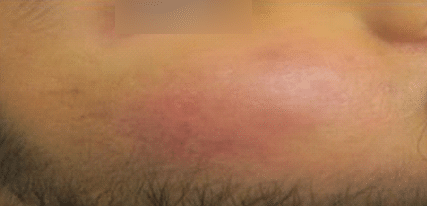
What is Acne Scar subcision?
Subcision is a treatment for acne scars in which a tiny needle is used to free up firm scar tissues that are pulling down your scar. Visible results of this procedure can be seen in 1 session. For best results, several sessions may be required. A combination of lasers and collagen-stimulating fillers would also enhance the improvements.
Collagen production is then triggered in areas where fibrotic strands are released. This allows the area to heal, which also leads to the improvement of the scar.
The decision to perform a subcision treatment depends on the scar's type, severity, and location. Subcision is usually used for treating depressed scars, bound-down scars, cellulite dimples, and wrinkles.
How does subcision for acne scars work?
Deep acne scars are released and lifted up using a special needle. This special needle is used to manually break down scar tissue that is anchoring down your skin.
The subcision acne scar procedure is more than just the mechanical release of the strands of fibrous scar tissue.
In fact, multiple healing processes bring about acne scar improvement. The mechanical action of the needle and the release of the scar tissue creates a pocket of blood beneath the skin.
Advantages of Subcision
- No risk of Post-inflammatory Hyper-Pigmentation (Not a Laser)
- Visible Results Instantly (versus weeks to months for Lasers)
- Versatile – Treats almost all scar types
The most important step to treat acne scars is to identify your scar type.
Rolling scars, as well as bound-down and tethered scars, need subcision treatment. If you see a depression/ dent when you smile or talk, this means that your scars are attached to the underlying structures, such as the muscle layer. Lasers cannot penetrate to the depth of muscle layers – not even with deep microneedling devices. Hence, you will need more than lasers to remove these stubborn scars.
You need subcision to release those tethered scars.
What Types of Scars Are Suitable for Subcision?
Subcision is an excellent treatment option for the following types of scars:
- Rolling acne scars
- Chickenpox scars
- Stretchable scars from injury or surgery
Subcision for Acne Scars FAQs
Preparation
Your skin is cleansed, and your scars are mapped out using a surgical pen. Local anaesthesia is injected to numb your skin.
Treatment
Dr. Sagoo may use a variety of needles/ tools catered to the scar type. Sharp needle or a tri-bevelled edge needle called a Nokor needle or a 23-gauge needle. Also, a blunt-edge cannula may be used in combination. Which needles are used is based on the expertise of Dr Sagoo, who has carried out several thousand Subcision procedures.
Upon insertion, the needle/cannula is directed to break the bands of scar tissue beneath your skin. You may feel the 'plucking' sensation as the needles break away the scar tissue, tethering the skin downwards.
Post-subcision recovery
Once the procedure is complete, pressure is applied to reduce bleeding and swelling. A topical antibiotic ointment is applied to prevent infection and encourage scar healing.
Subcision coupled with PRP
This involves subcision followed by injections of PRP as a spacer. PRP or platelet-rich plasma contains many growth factors and cytokines from platelets which are derived from your blood. It acts very similar to autologous blood – PRP is injected into the subcised area. Because PRP is less viscous than blood, the side effects are much less.
Fillers
Fillers add volume to the skin and are effective in treating patients with depressed, soft, rolling acne scars. They are not useful for ice-pick scars. They can be used alone or in combination with other procedures, such as Subcision.
Subcision and Fillers technique
This is for deep scarring. Filler is not used as a treatment for the scar itself but as a buffer or spacer. The primary mode of treatment is to free up the scar using subcision. Subcision itself gives permanent results, while filler only lasts one to two years at maximum. When the filler is present, it also stimulates collagen production. A tiny amount of filler is injected, namely 0.05 ml, into each subsised scar. This essentially acts as a buffer which stops the bonds from reforming.
Immediately after the procedure, there will be some redness and swelling that lasts 2-3 days. Pain is minimal post-treatment. Bruising is minimal after the procedure and will fade in 2-10 days, depending on your healing and skin type. Many patients are surprised at how quickly they recover after subcision and fillers.
Allow 2-3 days for the swelling to go away completely. Most swelling is due to the local anaesthesia injected.
Only little punctures in the skin will be visible as small crusts that peel in 3-5 days.
Bruising may be covered with makeup the first day after subcision.
All fillers may cause lumps and bumps, which usually is temporary.
Subcision is well-tolerated by most patients. The treatment is done under local anaesthesia to minimise discomfort.
Yes, the results of the Subcision are permanent.
Generally, 2-4 subcision sessions spaced about 4 to 6 weeks apart give the desirable results. This varies among individuals, scar location, scar depth and skin type.
The majority of individuals improve in their acne severity by 1-2 grades after 6 months post-procedure. There will be continued scar remodelling 3-6 months after the subcision for acne scars procedure.
Usually, a series of Subcision treatments are required 4-6 weeks apart, with each treatment improving at least 30 % more from the last treatment.
Mixed acne scarring is the most common form of acne scars. Therefore, combination treatments are necessary for acne scar revision.
Most patients who have acne scars will have a variety of scar types, including rolling, atrophic, ice pick scars, together with boxcar scarring. Dr. Sagoo usually combines subcision together with energy-based devices like the Fractora RF micro-needling system, lasers, TCA cross and other chemical peels.
In summary, subcision for acne scars is a very useful modality for the treatment of acne scar types. This is the preferred treatment for acne scarring. Dr. Sagoo still performs laser surgery for acne scars but always combines laser treatments with subcision for optimal acne scar results.
Subcision Gallery




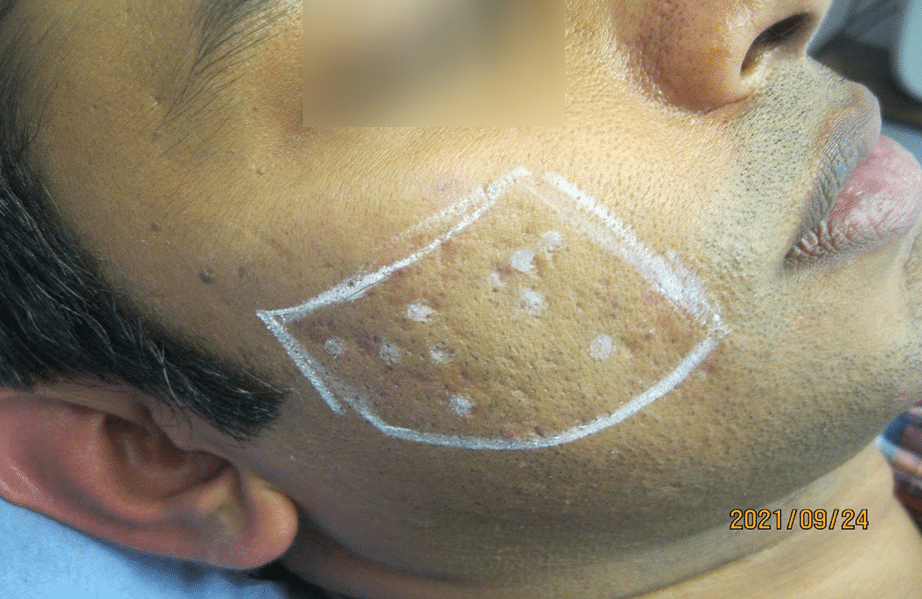

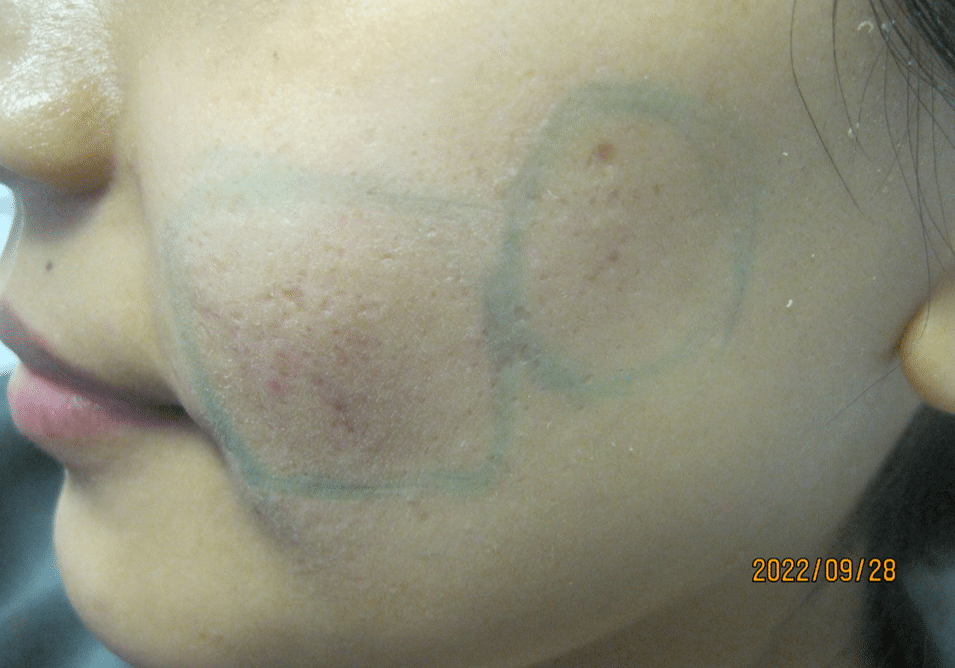





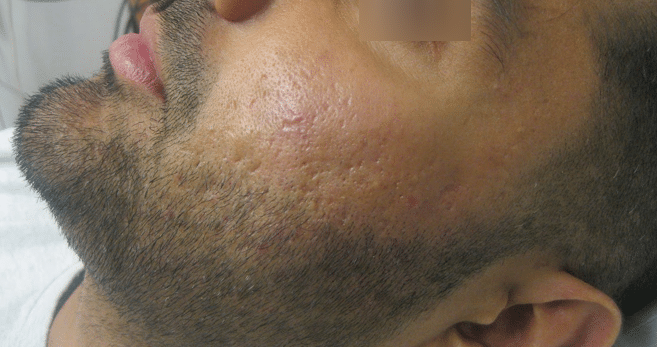
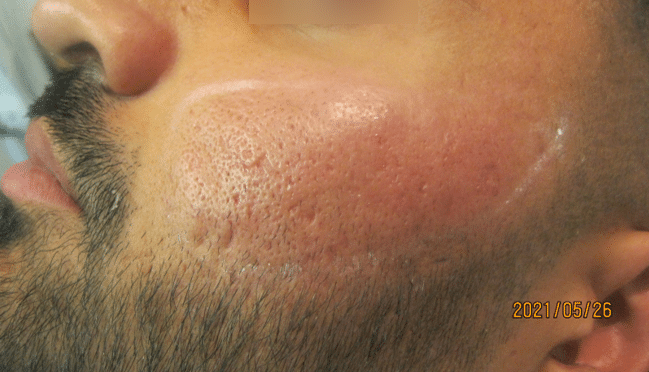
Tumescent medical Subcision for acne scars using the Taylor liberator.
Dr Sagoo is one of only 3 cosmetic doctors in the UK that carries out a procedure for acne scarring called medical Subcision under tumescent anaesthesia. This technique was founded by a doctor, Dr. Taylor, in the USA.
What is tumescent Subcision?
This is an advanced treatment for treating depressed rolling scars, which are tethered down by fibrous band strings to the deeper layers which cannot otherwise be lifted by laser or radiofrequency or laser. The depressed scars need to be released so that the scar is lifted, but this could cause complications such as bleeding, and nerve damage.
Dr. Sagoo uses a specially designed long-handled instrument that incorporates a 'W' shaped blunt tip. The tip resembles that of a flat-blade screwdriver. It has two notches (hence the 'W' profile), which contain a U-shaped blade that is sharp. The instrument is called the Taylors liberator, named after the doctor who invented it.
Using a specially made-up mixture of saline anaesthetic fluid (called tumescent fluid), we infiltrate the whole area around the scars so that the scarred skin is separated from any deeper structures that could easily be damaged.
This completely numbs the area where the scars are, also making it safer and more comfortable for the patient.
Once the area is numb and swollen with fluid, Dr Sagoo will then make a tiny incision and introduce a specially designed scar-releasing blunt instrument to cut and release the fibrous band, pulling the scars down. This is called a Taylor liberator instrument.
Moving this instrument back and forth in the anesthetised layer of the skin will allow the scars to spring up almost immediately, having cut the fibrous bands within the notches of the tool. The patient feels no pain or discomfort as this is happening, leading to an instant improvement in the scar appearance. There are no stitches needed for this procedure.
The tumescent anaesthesia used in full-field Taylor Liberator Subcision causes swelling of the face but has largely resolved 24-48 hours after the procedure.

This subcision method allows for complete separation and release of fibrotic bands with minimal bleeding swelling. It offers a swift recovery and sustains long-term results without the need for repeated treatments.
Combination therapy provides superior results in cosmetic practice. Acne scarring is often treated using an ablative laser, and outcomes are significantly superior when used in combination with a single subcision session.
It has been reported that patients with rolling acne scars, treated in 1 session with a trichloroacetic acid chemical peel, subcision with the 'liberator', and CO2 laser under tumescent anaesthesia have significant results.
The Taylor Liberator subcision is performed about a month before combined fully ablative CO2 resurfacing.
Recovery, what to expect.
Swelling from the tumescent is dissipated within the first 24 hours, with normal facial contour returning within this time. A further 24 hours should pass before dressings are removed – this ensures sufficient wound integrity of the entry ports. At this stage, the face can be washed normally, and patients can return to work with little to no bruising. Patchy numbness is to be expected, and this usually resolves within 3 months of the procedure.
A full consultation and assessment will be required with Dr. Sagoo to establish if this advanced procedure is suitable for you.
Acne scarring can be a distressing condition, but with advanced techniques like Subcision, significant improvements can be achieved. Dr. Sagoo’s expertise in medical-grade Subcision, combined with innovative procedures like the Taylor Liberator, offers exceptional results.
By understanding your specific scar type and tailoring treatment accordingly, we can help restore your skin's confidence. Book a consultation today to discuss your options and embark on your journey to clearer, smoother skin.
